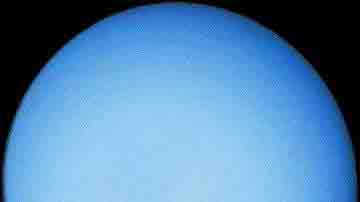|
         
> The Sun
> Mercury
> Venus
> Earth
> Mars
> Jupiter
> Saturn
> Uranus
> Neptune
> Pluto
> The 10th Planet?
> Asteroids
> Comets
> The 'Edge'
  
|
Uranus was the first
planet to be discovered in modern history. It was actually discovered by
accident in 1781 by William Herschel.
Like the other gas giants, Uranus has a very thick cloud cover and an
atmosphere made up mostly of hydrogen, helium, methane, and ammonia. The
trace amount of methane is what gives Uranus and its twin, Neptune, their
blue color. Unlike Saturn and Jupiter, Uranus has a different internal
structure.
The core of Uranus is probably composed of liquid rock. Then, farther up,
the liquid rock slowly gives way to an ocean made mostly of hydrogen,
helium, and water, with small amounts of ammonia and methane. This "ocean"
accounts for most of Uranus's bulk. Then, the water slowly thins out into
the bland, almost featureless atmosphere.
Uranus also has a system of about 11 rings - not nearly as large as
Saturn's. Nine were found when Uranus passed in front of a bright star,
the rings causing the star to temporarily disappear when they passed in
front of it. This was the first time astronomers had detected rings around
any planet other than Saturn. It was the first time, also, that
astronomers had detected thin rings around any planet. The other two rings
were found when Voyager 2 passed by.
Uranus also has 26 known moons, most of which little is known about.
Explorations
After flying past Saturn, Voyager 2 was directed towards
Uranus. It passed within 80,000 km (50,000 mi) of the cloud-covered planet
in January 1986, discovering four more rings as well as ten new moons. The
spacecraft came even closer to one of the moons, Miranda, transmitting
startling pictures of that icy body. Voyager 2 then headed for Neptune,
flying within 5,000 km (3,100 mi) of the planet in August 1989 and
discovering six additional Neptunian moons before it headed into the
depths of the solar system.
[Top] Unique
Characteristics
Uranus has two main unique features. First, there is
absolutely no detail in the cloud cover. Only when pushed to the maximum
level of color enhancement and contrast on computers do scientists start
to see small swirls in the atmosphere.
Second, Uranus is the only planet rotates on its side. This produces the
strangest seasons of any planet in the solar system. For 21 years,
Uranus's moons are seen as one would view a dart board, with one pole
facing the sun. The next 21 years Uranus has its side to the sun, and the
moons move up and down across the equator. then the cycle repeats itself
starting with the other pole. Scientists aren't sure why this is, but they
think that a large body smashed into it with such force that it pushed the
planet over.
[Top] Uranus'
Satellite
Uranus has 26 moons. Titania, the largest, is about half
the size of our own moon. The moons are all made of ice and rock. Most of
the moons, including Titania, Oberon, and Umbriel, seem to be "normal"
moons without anything interesting; however, Miranda and Ariel seem to
have had violent pasts. Most of the moons appear to be captured
asteroids
due to their size and orbits.
The two innermost moons of Uranus, Cordelia and Ophelia, act as shepherd
moons. They have orbits on either side of the last ring, epsilon, which
keeps it narrow. Scientists believe that each of the other rings have
shepherds, too, but they must have been too small for the Voyagers'
cameras to detect.
The next eight moons are Bianca, Cressida, Desdemona, Juliet, Portia,
Rosalind, Belinda, and Puck, all named for Shakespearian characters.
Inside of Belinda's orbit is a moon designated as S/1986 U10. It has not
been named because there is controversy over whether or not it really
exists; the International Astronomical Union (IAU), the only official
naming body has yet to designate it as a real moon.
Next out is Miranda. It is the smallest of Uranus' moons that is visible
from the Earth. It has some of the most interesting surface features in
the solar system. First, it has a cliff that is about 19 km (12 miles)
high. If this were scaled to be on Earth, it would reach into the orbit of
spacecraft. It also has three long, rectangular shapes, called "coronae."
Scientists think that at one time the pull of the other moons warmed the
interior and caused the ice in Miranda to start to rise. The coronae mark
where it froze before coming to the surface.
Ariel , next, is covered with complex fractures and grooves. Probably they
are the result of ice seeping to the surface, then freezing and expanding.
Ariel also has lava-filled valleys. The lava is made of a mixture of water
and liquid ammonia
Next comes Umbriel, equal in size to Ariel, but with a bland, nondescript
surface.
Next out is Titania and Oberon . Titania is the biggest moon of Uranus. It
looks like a larger version of Ariel. Oberon is only a little smaller than
Titania. Oberon has a crater-peppered surface of little interest. However,
it does posses a mountain that is twice the height of Mt. Everest.
The next moons, Caliban, Stephano, Sycorax, Prospero, and Setebos were
discovered in just the past few years by re-examining
Voyager 2 images.
Very little is known about them, except that they all have retrograde -
they orbit in the opposite direction of the planet's spin - orbits,
leading to the conclusion that they are captured asteroids rather than
native to the Uranian system. Inside of Sycorax's orbit is a moon
designated as S/2001 U1, which also has retrograde motion. The IAU has yet
to give it a name.
[Top] External Links
[Back] [Top] [Next] |
